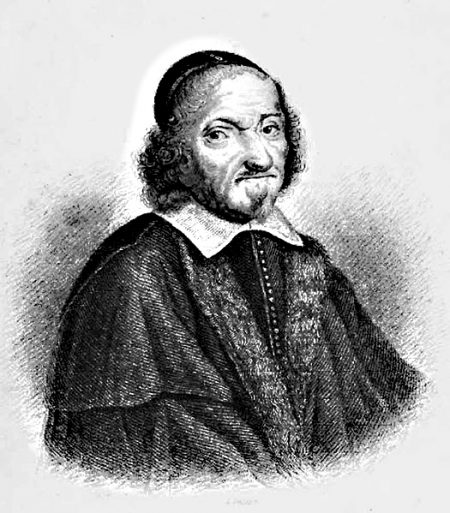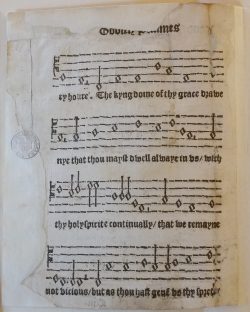
As William Tyndale, the courageous translator of the English Bible, was being bound to the stake on the morning of October 6, 1536, he lifted up his eyes to heaven with one final prayer, “Lord, open the King of England’s eyes!” Upon those words, the rope was drawn tight and the body of William Tyndale was burned to ashes. But God heard the dying prayer of His faithful martyr. Two years later, King Henry VIII granted his royal benediction upon the printing and distribution of the English Bible.
This remarkable change of events was providentially orchestrated by the God of Heaven. The human instrument that the Lord used was a humble man named Myles Coverdale. Myles Coverdale was born in 1488 in Yorkshire. After completing his studies at Cambridge, Coverdale was ordained as a priest and became an Austin friar, a scholastic order marked by black robes and hoods.
Coverdale was a friend and follower of Robert Barnes, an early English reformer who was condemned as a heretic by Cardinal Wolsey and burned to death at Smithfield. He also formed close friendships with men like Thomas Bilney and Hugh Latimer. Coverdale left the friars in 1527 and started wearing ordinary clothing. He began preaching the simple truths of the Reformation, that salvation is by grace alone in Jesus Christ alone. The young scholar also began translating some of the works of Continental Reformers like Luther into English.
The Church of England had separated from the papacy, but the doctrine of the church was still far from Reformed. King Henry VIII had selfish personal reasons for separating from papal authority, but the king clung tenaciously to the superstitions of the Roman sacraments. Persecution was getting hot against those who preached reform, and Myles Coverdale deemed it wise to flee England for the Continent near the end of 1528. He lived for a while at Antwerp, assisting William Tyndale in the work of translating the Scriptures from Hebrew and Greek into English. When Tyndale was betrayed by a man he had kindly befriended, Coverdale continued Tyndale’s work alone, laboring faithfully to complete Tyndale’s translation. He used Tyndale’s entire New Testament along with the portions of the Old that Tyndale had finished before his death, namely the five books of Moses and the book of Jonah. Coverdale used other sources like the German Bible of Luther and the Latin Vulgate to complete the English Old Testament, hoping one day to strengthen his own knowledge of Hebrew.

Myles Coverdale also produced an English Psalter that became an important part of the Book of Common Prayer. He also translated many of Luther’s hymns into English and published the entire collection under the title Ghostly Psalms and Spiritual Songs. His careful work on the Psalter influenced all subsequent English Psalters and emphasized the importance of congregational singing in the Protestant Reformation.
The Coverdale Bible was followed by the Matthew’s Bible and then the Great Bible, all leaning largely upon Tyndale’s work of translation and Coverdale’s work of editing. As the tide began to turn toward the Reformation, Coverdale found a valuable friend in Thomas Cranmer. The title page of the Coverdale Bible urged readers to “take these words into thy heart, and be not an outward hearer but a doer.” Coverdale returned to England in 1539 to assist their efforts and continue his translation work. Subsequent additions of the English Bible known as the Matthew’s Bible and the Great Bible utilized the Hebrew skills of Coverdale’s friend John Rogers.
During his time in England, Myles Coverdale married Elizabeth Macheson. When the tide of the king’s vacillating opinions began to turn again and the marriage of priests was made illegal, Coverdale and his new bride again took refuge on the continent, settling in Strasburg. During his second exile, Coverdale preached for other English exiles and continued his work of translating important German books into English, all the while studying Hebrew to give him a better grasp on completing the translation of the Old Testament.
Coverdale returned to England in 1548 upon the ascension of Edward VI to the throne. This was a time of great progress for the cause of Reform. Coverdale became royal chaplain and was appointed to be the almoner to the surviving widow of Henry VIII, Queen Catherine Parr. Coverdale was appointed Bishop of Exeter in 1551 and took the pulpit of that important seat of ecclesiastical influence, using his bishopric not to enrich himself, but to promote the cause of truth throughout his charge.
The sudden change of power in 1553 from Edward to Bloody Mary brought Coverdale into grave danger. He was summoned before the Privy Council and formally ejected from his see and placed under house arrest. He fully expected to be burned at the stake. But the timely pleading of his brother-in-law, who was chaplain to King Christian III of Denmark, spared his life. The King of Denmark himself wrote to Bloody Mary and urged her to spare Coverdale. Coverdale and his wife left England for a third exile and sailed for Denmark. From there they moved south and settled in Geneva where Coverdale assisted other Marian exiles in the translation of the Geneva Bible. His experience in translation work was of great assistance to the translation team in Geneva.
In 1559, after the death of Mary and the ascension of Elizabeth I, Coverdale returned to London. He had adopted the Genevan views on ceremonies and vestments, and was considered one of the early Puritans. His stance on ceremonies prevented his re-installment as Bishop of Exeter, but he cared more for truth than for fame or power.
Coverdale outlived his first wife, and married a Godly young lady named Katherine in 1565, which sweetened the sunset of his days. He became an early leader in the Puritan movement, and died a poor and almost forgotten man in 1569 at the age of 80. By the time of his death, the English Bible was available to every plow boy and homes and churches were filled with men, women, boys, and girls singing the psalms and hymns that he collected. This is the legacy of Myles Coverdale, a humble and faithful servant of the Lord.
Bibliography
Forgotten Reformer: Myles Coverdale and the First Forty Years of the English Reformation by G. F. Main




